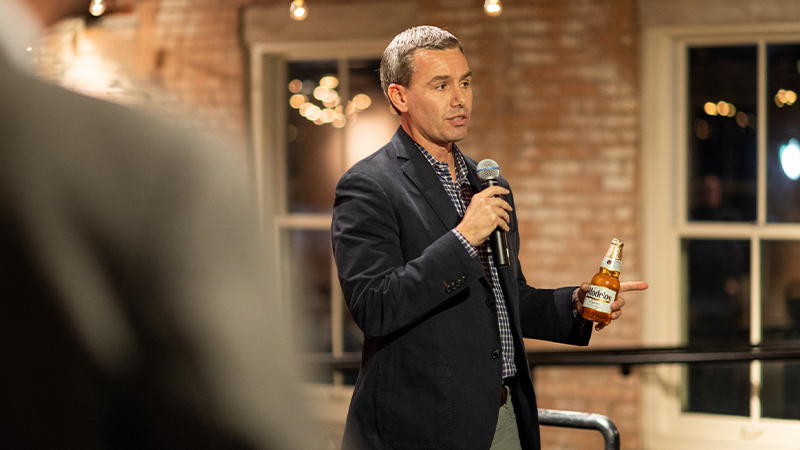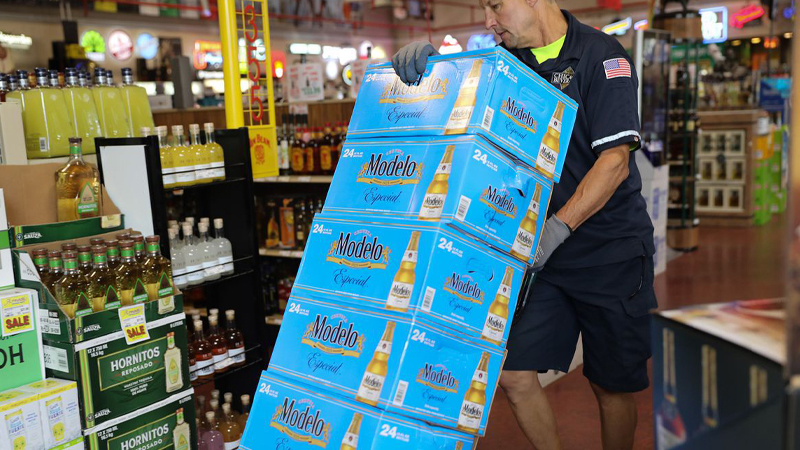The most important beer in America right now wears no crown and claims no royal lineage, though neither is it shy about touting its special status. I’m talking, of course, about Modelo Especial, a Mexican pilsner-style lager that, by whichever metric you measure it, is on fire.
You’re no doubt familiar with Especial, having perhaps picked at its gold foil while enjoying tacos at a Mexican restaurant at any point during the last 10 years. But what do you really know about this brand?
Are you familiar with the fact that it’s currently the second best-selling beer in America, for example, falling only behind Bud Light in dollar sales? Did you know that Modelo Especial — not Corona, not Heineken, not Stella Artois — has cemented its status as the best-selling imported beer in America? And did you realize that Especial is the only top-five- selling beer in this country that does not fall into the hugely lucrative “light” or “lite” category?
All of which is no small feat considering Modelo Especial isn’t even the most famous Mexican brew to enter the U.S. market. So how did we arrive at this point?
Modelo By the Numbers (and Metrics)
Though its label proudly bears the year 1925, for this story’s purposes, we can pick up the tale on June 7, 2013. This was an important day in the American beer industry: the day when Constellation Brands acquired the exclusive rights to import and market six of the top 20 imported beers in the United States, among them Corona and Modelo.
Now Modelo probably didn’t seem like the jewel among this crown at the time; that distinction, fittingly, would have gone to Corona. But via a lot of hard work and shrewd marketing, Modelo Especial has since become a behemoth in the beer industry.
Let’s consider the numbers. In IRI-tracked off-premise channels, Modelo Especial was the second best-selling beer in terms of dollar sales for the past 12 weeks, and the third best seller over the last year. Year to date, it is the No. 1 growth beer brand, racking up $144 million in extra sales compared to the same period in 2020. Per Nielsen data, Modelo Especial has been the No. 1 imported beer in America and a top-five brand since at least 2018. With sales totaling more than $2.8 billion last year, it landed just $86 million shy of outperforming the second and third best-selling beers combined (Corona Extra and Heineken).
“The success, the size, and the continued growth of the brand is phenomenal,” says Greg Gallagher, Constellation’s vice president, brand marketing, Beer Division. On that continued growth, another tasty statistical nugget: Modelo Especial has grown by double digits in 35 of the last 38 years, according to the brand’s proprietary data.
If you’re conflicted over whether to feel more shocked or impressed by the numbers, you’re likely not alone. Despite its impressive sales, Modelo Especial remains relatively unknown among the drinking public.
In terms of unaided brand awareness, a metric based on studies where consumers are asked to list the brands at the top of their minds, Modelo featured in the lists of just 7 percent of general market drinkers, according to Gallagher. By contrast, Corona’s share is close to 35 percent.
Something else this statistic highlights is the fragmented status of Especial’s popularity. It’s not that everyone, everywhere is reaching for a bottle or can if they’re not drinking Bud Light. But in the markets where the brand has taken off, people really, really like it.
Most notable among those are Chicago, Dallas, San Diego, San Francisco and Oakland, Las Vegas, Sacramento, and Los Angeles, the seven regions where Modelo Especial is the best-selling beer, according to IRI data. And in Los Angeles, Modelo Especial is bigger than Bud Light, Coors Light, and Miller Lite combined, says Gallagher.
Transcending Trends
That Modelo Especial holds its own so valiantly against light lagers is possibly the largest, most attractive feather in its cap.
“The health and wellness trend is prevalent across all categories — beer, wine, and spirits — and it’s also what’s given rise to the popularity of seltzer,” says Scott Scanlon, an executive vice president at IRI. Given this landscape, and the fact that Modelo does not specifically market itself to drinkers of “better-for-you” products, the growth is “even more astonishing,” he says.
“We’re kind of the outlier,” Gallagher agrees. “But while we’re not a low-calorie light beer, there are a lot of consumers who still view Modelo and Mexican lager as a pretty light, sessionable beer. It’s not like we’re an IPA or some heavy craft beer.”
This may very well be true but there are others in the industry who believe Especial’s success owes something to its appeal to craft beer drinkers — another notable outlier where “macro” brews are concerned.
“It was let into the craft beer club very early on,” says Lester Jones, chief economist at the National Beer Wholesalers Association. “Ten years ago, if you were out in the craft beer market, you would always see a tap handle of Modelo Especial.”
Jones attributes the brand’s rise to Constellation’s success with “old-school” beer marketing. He says its team did a great job of getting people drinking it on-premise. Those folks then went to grocery stores and started asking for Especial. And in turn, the grocery stores asked their distributors to supply it to them. “That’s the old-school way of building a brand to national recognition and distribution,” Jones says.
Within the realm of imported beers, Jones also points out that Mexican lager is decidedly hot right now. Where German beers dominated in the ’70s and ’80s, followed by Canadian brews, Mexican imports have held pole position since the late ’90s and early 2000s, he says. Modelo Especial has certainly played a large role in more recent times. Year to date, the brand contributed 65 percent of the dollar growth of all imported beers in IRI’s channels.
When Jason Murphy joined Buffalo Wild Wings as beverage innovation manager in 2017, the dominance of Mexican lager in certain states prompted him to suggest the casual dining and sports bar chain should take a more regional rather than national approach to its beer program.
“We had two Mexican lagers in every Buffalo Wild Wings across the country,“ he says. “It was pretty evident that in areas like Southern California or in states like Arizona, New Mexico, and Texas, we should instead have four to five of these import brands because they were doing so well.”
On Modelo Especial specifically, he shares another example of its popularity. BDubz previously discounted the brand, but with the trend of premiumization seen across all alcohol segments, the chain has since stopped doing so. Even at a higher price, volume sales never dropped off. “If you want a Modelo, you’re going to order a Modelo, whether it’s on a happy hour special or not,” Murphy says. “That’s one of the powerful things about this brand.”

Catering to Core Consumers
If that phenomenon sounds like the product of particularly shrewd marketing, you might be surprised to learn that Modelo Especial only started running English language ad campaigns six years ago. Prior to that, everything was targeted toward the brand’s “core” Mexican and Hispanic consumer base, Gallagher says. Those efforts have since seen the brand’s “household penetration” — one of the major metrics it uses to gauge performance — rise 20 percent among non-Hispanic drinkers.
Of course, the brand hasn’t ignored its core base or the regions in which it performs best. Modelo’s marketing campaigns have included partnerships with various sports franchises, including the Las Vegas Raiders, LA Galaxy, Chicago White Sox, and Golden State Warriors.
Since 2018, Modelo Especial has also been the official beer sponsor of the UFC in the United States, a move that Murphy believes to be particularly canny, based on Buffalo Wild Wings’ own work with the mixed martial arts organization. “I would assume that if you laid the three consumer cohorts on top of each other — Buffalo Wild Wings, UFC, and Modelo — they would all overlap quite nicely,” Murphy says.
Whether now or in the long run, it surely doesn’t harm matters that the population of the brand’s “core” drinkers is also rising. Between 2010 and 2019, the U.S. Hispanic population rose 10 million (20 percent), according to U.S. Census Bureau estimates.
“[S]ince the brand resonates well with Hispanic households, this would in theory point to an increase in the core consumer base for the Modelo Especial brand,” Dave Williams, vice president of analytics and insights at BUMP Williams Consulting, tells me via email.
Further signs that Constellation caters well to its fan base include the launch of 32-ounce bottles, which Gallagher says the brand introduced two or three years ago to mimic the 40-ounce bottles that are popular in Mexico. On the other end of the scale, Modelo last year debuted 7-ounce bottles, also known as “Modelitos.” This way, every last sip of beer enjoyed in warmer markets can arrive ice cold and refreshing.
All things considered, it’s difficult to pinpoint the most remarkable facet of Modelo Especial’s tale. Is it the three decades of continued double-digit growth? Or maybe the fact the brand somehow managed to strike that elusive chord with both mass-market and craft beer drinkers? Perhaps we should just enjoy the beauty of the narrative — that Especial took the imported beer crown from Corona and dethroned Budweiser as the king of (non-light) beers in America.
One thing that cannot be contested: The $4.75 billion Constellation paid for the Grupo Modelo portfolio was the best deal in beer since happy hour was invented.
This story is a part of VP Pro, our free platform and newsletter for drinks industry professionals, covering wine, beer, liquor, and beyond. Sign up for VP Pro now!

